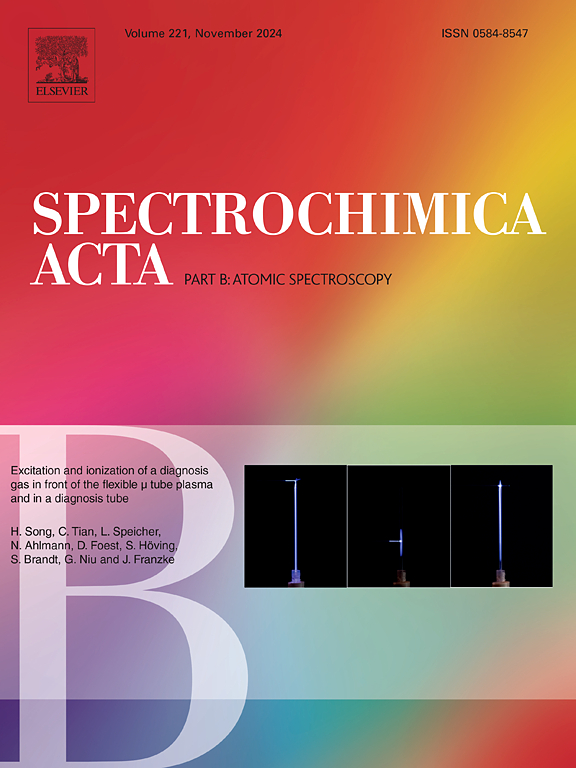Online elemental characterization of collimated nanoaerosols by laser-induced breakdown spectroscopy of isolated particles
IF 3.2
2区 化学
Q1 SPECTROSCOPY
引用次数: 0
Abstract
We present a new setup for the online elemental characterization of nanoaerosols during their gas-phase synthesis using Laser-Induced Breakdown Spectroscopy (LIBS). This system involves the interaction of a kHz rate pulsed laser with a collimated jet of particles under vacuum conditions (10−2 mbar). The low-pressure interaction reduces spectral line broadening, enhances spectral resolution, and eliminates the background continuum from the laser-gas interaction, improving LIBS detection capabilities. A sampling stage has also been incorporated into the design, enabling the continuous analysis of nanoaerosols during their high-throughput synthesis. This feature enhances the instrument's versatility and opens new possibilities for studying nanoparticle formation and properties in situ and in real-time.
The proof of concept was produced by an experiment of online elemental analysis of Li2TiO3 nanoparticles during their synthesis by laser pyrolysis. The monitoring of the LIBS emission signal of the particles in real time was demonstrated by measuring the signals from the three elements together with data conditional analysis to extract the events information. Moreover, the specific detection of Li signals was achieved in a single-nanoparticle detection mode, enabling it to reach an absolute detection limit of 150 ag. The collimation step of particles in a jet, combined with a high repetition rate laser, opens the way to specific monitoring of low-density aerosols in the sub-micrometer range.

求助全文
约1分钟内获得全文
求助全文
来源期刊
CiteScore
6.10
自引率
12.10%
发文量
173
审稿时长
81 days
期刊介绍:
Spectrochimica Acta Part B: Atomic Spectroscopy, is intended for the rapid publication of both original work and reviews in the following fields:
Atomic Emission (AES), Atomic Absorption (AAS) and Atomic Fluorescence (AFS) spectroscopy;
Mass Spectrometry (MS) for inorganic analysis covering Spark Source (SS-MS), Inductively Coupled Plasma (ICP-MS), Glow Discharge (GD-MS), and Secondary Ion Mass Spectrometry (SIMS).
Laser induced atomic spectroscopy for inorganic analysis, including non-linear optical laser spectroscopy, covering Laser Enhanced Ionization (LEI), Laser Induced Fluorescence (LIF), Resonance Ionization Spectroscopy (RIS) and Resonance Ionization Mass Spectrometry (RIMS); Laser Induced Breakdown Spectroscopy (LIBS); Cavity Ringdown Spectroscopy (CRDS), Laser Ablation Inductively Coupled Plasma Atomic Emission Spectroscopy (LA-ICP-AES) and Laser Ablation Inductively Coupled Plasma Mass Spectrometry (LA-ICP-MS).
X-ray spectrometry, X-ray Optics and Microanalysis, including X-ray fluorescence spectrometry (XRF) and related techniques, in particular Total-reflection X-ray Fluorescence Spectrometry (TXRF), and Synchrotron Radiation-excited Total reflection XRF (SR-TXRF).
Manuscripts dealing with (i) fundamentals, (ii) methodology development, (iii)instrumentation, and (iv) applications, can be submitted for publication.

 求助内容:
求助内容: 应助结果提醒方式:
应助结果提醒方式:


